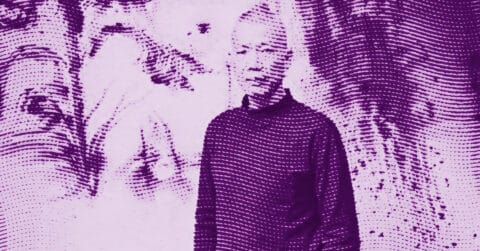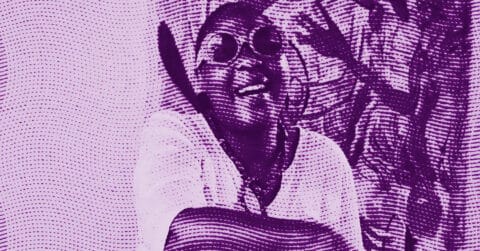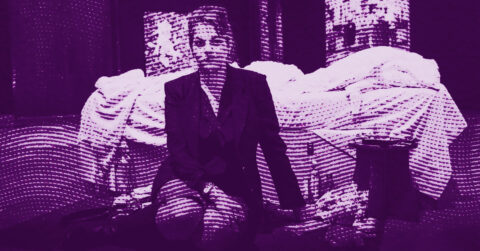Listen to me carefully, you bunch of snobs: Jennifer Guidi paints the universe with sand. Not like a child playing in a sandbox, but like a contemporary alchemist who transforms the most humble material into a cosmic revelation. From her Los Angeles studio, this artist born in 1972 in Redondo Beach creates a unique body of work where painting meets meditation, where geometric abstraction embraces Eastern spirituality, where each canvas becomes a mandala vibrant with pure colors.
Guidi’s work goes beyond traditional categories of contemporary art. She mixes pigments, oil, acrylic, and sand using a personal technique that transforms the pictorial surface into a tactile relief. Each painting is born from a repetitive and meditative gesture: the artist applies wet sand with a brush, then digs thousands of small cavities using a wooden dowel, creating patterns that radiate from a decentered central point towards the left, where the heart of the viewer facing the artwork beats.
This seemingly simple practice reveals a remarkable philosophical complexity. Guidi draws her inspirations from multiple sources: the Berber carpets of Morocco whose patterns she photographs on the reverse side, the Tibetan mandalas she discovered during a performance by Buddhist monks, the particular light of California that bathes her canvases in a unique clarity. Her creative process resembles a form of secular prayer, a daily ritual she fulfills in her studio to the rhythm of contemporary hip-hop.
The American literary tradition
Jennifer Guidi’s art maintains deep ties with the American literary tradition, particularly that of Transcendentalism and the Beat Generation. Her pictorial practice evokes the meditations of Henry David Thoreau on nature and cyclical time. Like the author of Walden, Guidi carefully observes the transformations of the Californian landscape, capturing the fleeting nuances of sunsets on the mountains, the plays of light in the urban smog of Los Angeles.
This kinship with Thoreau is no coincidence. Guidi shares with the writer a contemplative approach to creation, a sustained attention to natural rhythms, a search for the essential through the progressive purification of means of expression. Her paintings of mountains, where colored chains unfold under vibrant skies, recall the descriptions Thoreau makes of Mount Katahdin in The Maine Woods. For both of them, nature becomes a pretext for an inner exploration, a mirror where human consciousness reflects in its quest for meaning.
The influence of the Beat Generation also shines through in Guidi’s work, notably in her relationship with Eastern spirituality and meditation. Like Jack Kerouac in The Dharma Bums, she draws from Tibetan Buddhism both formal and conceptual inspiration. Her sand mandalas evoke the spiritual journeys of Kerouac’s heroes, this search for an absolute accessible through the repetition of gesture and the abandonment of the creative ego. Gary Snyder, Beat Generation poet and Zen practitioner, is an explicit reference for Guidi: several of her artwork titles, With a Magnetizing Force I Pulled the Sky Over Me, A Stillness Spread Over the Sea, directly evoke Snyder’s poetic universe and his pantheistic celebration of wild nature.
This literary lineage illuminates the narrative dimension of Guidi’s work. Each painting tells a story, that of a creative process akin to the automatism of surrealists or the spontaneous improvisations of Beat poets. The artist herself describes her work as “an introspective psychological journey” [1], an exploration of the unconscious territories of the human soul. Her canvases function as inner travel diaries, maps of the invisible where each colored dot corresponds to a moment of awareness, to a pulse of life.
The obsessive repetition of the creative gesture in Guidi’s work also evokes Gertrude Stein’s writing techniques, another major figure of American literature. Just as Stein tirelessly repeated the same syntactic formulas to create effects of verbal hypnosis, Guidi carves thousands of small cavities according to an unchanging rhythm that generates a form of visual trance. This kinship reveals the artist’s profound ambition: to transform painting into a universal language, to create a plastic vocabulary capable of communicating directly with the viewer’s soul, beyond cultural and linguistic barriers.
Guidi’s work thus fits within an American tradition that considers art as a means of spiritual exploration and personal transformation. From Ralph Waldo Emerson to Allen Ginsberg, from Walt Whitman to Gary Snyder, this lineage of artists and writers has always sought to transcend the limits of Western individualism to access a broader cosmic consciousness. Guidi extends this quest by other means, substituting poetic verb with the materiality of sand and color, creating works that function as visual mantras, meditation supports for the contemporary eye and mind.
Platonic architecture
The analysis of Jennifer Guidi’s work reveals a rigorous geometric construction that evokes Plato’s philosophical speculations on ideal forms and cosmic harmony. Her circular, triangular, and serpentine compositions are not by chance but are part of a deep reflection on the fundamental structures of the universe and human consciousness.
The predominance of the circle in Guidi’s art directly references the Platonic developments on geometric perfection. In the Timaeus, Plato describes the cosmos as a perfect sphere, the most beautiful and uniform shape there is. Guidi’s circular mandalas operate according to this logic: they propose an image of totality, a microcosm where the universal order is reflected. Each colored dot emanating from the center to the periphery evokes the individual souls who, according to Platonic cosmology, participate in the World Soul while retaining their singularity.
This cosmological dimension is enriched by a reflection on the theory of knowledge developed in the Republic. Guidi’s paintings function like allegories of the reversed cave: instead of turning us away from the sensible world to access the world of Ideas, they invite us to rediscover intelligible beauty at the very heart of matter. Sand, the most prosaic element there is, becomes under the artist’s brush the medium of an aesthetic revelation. This transubstantiation of base matter into pure beauty perfectly illustrates the process of anamnesis described by Plato: Guidi’s art awakens in us the memory of the Idea of Beauty, asleep in the folds of the embodied soul.
The rigorous geometry of her compositions also evokes Pythagorean speculations on the harmony of the spheres. Guidi organizes her colors according to precise mathematical ratios, exploring the chromatic theories of Goethe and Schiffermüller which she translates into monumental paintings. Her triangle of nine colors inspired by Goethe functions as a diagram of the human mind, linking color combinations and emotional states according to an almost musical logic. This synesthetic approach to color recalls Platonic intuitions on the fundamental unity of the cosmos, where mathematics, music, and beauty participate in the same harmonic order.
The recurring use of the triangle in Guidi’s work is particularly interesting. This geometric form, charged with symbolism since Antiquity, evokes both the Egyptian pyramids and the Californian mountains that inspire the artist. But beyond these iconographic references, the triangle refers to the ternary structure of the soul described in the Republic: reason, courage, and temperance find their balance in justice, the cardinal virtue that ensures the harmony of the individual and the city. Guidi’s triangular compositions thus propose a plastic meditation on psychic balance, a geometry of the soul that aims to reconcile the contradictory forces of the human psyche.
The serpent, another recurring figure in the artist’s iconography, also fits within this Platonic reading. Symbol of the kundalini in the Hindu tradition, it evokes the spiritual energy that sleeps at the base of the spine and rises towards consciousness through a helical movement. This image of spiritual ascension resonates with the allegory of the line developed in the Republic, where Plato describes the progressive degrees of knowledge from the shadows of the cave to the contemplation of the Good itself. Guidi’s serpents function as mystical ladders, pathways to access higher states of consciousness.
This symbolic architecture reveals the metaphysical ambition of Guidi’s art: to create images that do not merely please the eye but truly transform the viewer’s consciousness. Her paintings function as spiritual exercises in the sense that Pierre Hadot defines ancient philosophy: concrete practices aimed at changing our relationship to the world and to ourselves. By contemplating these colorful mandalas, the spectator experiences this conversion of the gaze (periagoge) that Plato places at the heart of philosophical education. Art thus becomes a vehicle of wisdom, a means of access to a truth that transcends sensible appearances without rejecting them.
Guidi’s originality lies in her ability to update these Platonic intuitions through contemporary art means. Her paintings are not illustrations of philosophical concepts but autonomous aesthetic experiences that revisit, through other paths, the great questions of Western metaphysics. They prove that art can still serve as an organon of thought, as an instrument of knowledge and spiritual transformation for the contemporary man in search of meaning and the absolute.
Jennifer Guidi in the contemporary art market
Jennifer Guidi’s meteoric rise in the contemporary art market deserves analysis. In a few years, her works went from 50,000 euros in galleries in 2014 to more than 430,000 euros excluding fees at auction in 2022 at Christie’s for Elements of All Entities. This spectacular progression raises questions about the mechanisms of artistic valuation in a globalized economic context.
The commercial strategy developed around Guidi’s work reveals a sophisticated mastery of contemporary market codes. Simultaneously represented by Gagosian, David Kordansky, and Massimo de Carlo, the artist benefits from a particularly efficient international distribution network. This multi-representation, increasingly common in the gallery world, reflects the professionals’ confidence in the commercial potential of her creations. The strict control exercised by the artist and her galleries over the placement of her works, a technique also used by Mark Grotjahn, her ex-husband, helps to artificially maintain the scarcity and thus the market value of her production.
This economic mechanism provokes bitter criticism. Collector and dealer Stefan Simchowitz denounced on Facebook in 2017 the speculative enthusiasm around Guidi’s works: “If one more person asks me to get them a work by Jen Guidi, I think I’m going to vomit in my bed” [2]. This media outburst, as vulgar as it is, reveals the tensions that traverse the contemporary art market, torn between aesthetic legitimization and financial logic.
The sociological analysis of Guidi’s clientele sheds light on these issues. Her collectors, Steven A. Cohen, Maurice Marciano, and François Pinault, belong to an international financial elite that uses art as an investment tool and social marker. The assumed “decorative” dimension of her paintings, their ability to create a soothing atmosphere in contemporary interiors, facilitates their integration into private collections where the value of use often takes precedence over pure aesthetic value.
This apparent contradiction between claimed spirituality and assumed commercial success characterizes contemporary art in its ambiguous relationship with cultural capitalism. Guidi claims a meditative practice, a search for spiritual authenticity, while accepting the rules of a market that transforms her works into luxury consumer goods. This tension does not invalidate her artistic approach; rather, it reveals the complex conditions under which contemporary art is developed, caught between aspiration for aesthetic autonomy and integration into dominant economic circuits.
Towards an Aesthetic of Presence
Jennifer Guidi’s work ultimately offers a singular aesthetic experience, founded on immediate presence to the work and the world. Her paintings function as machines to slow down time, contemplative devices that resist the generalized acceleration of contemporary society. In a world dominated by digital images and the rapid consumption of visual content, Guidi’s art claims a different temporality, one of contemplation and meditation.
This aesthetic of presence is rooted in a deep understanding of Eastern spiritual traditions. Guidi has practiced daily meditation for over ten years, and this discipline is reflected in every aspect of her work. Her paintings arise from a particular state of consciousness, a sustained attention to gesture and the present moment that transforms the act of painting into a spiritual exercise. The viewer, facing these colorful mandalas, in turn experiences this state of amplified presence.
Guidi’s originality lies in her ability to translate this spiritual experience into contemporary plastic language. Her references to Goethe’s color theory, the chakras of Hindu tradition, Tibetan mandalas, are integrated into a personal synthesis that avoids the pitfall of decorative orientalism. The artist does not copy traditional forms but reinvents a spiritual iconography adapted to contemporary Western sensibility.
This reinvention involves a clever use of pure color. Guidi exploits the psychophysiological properties of color to create optical vibration effects that alter the viewer’s perception. Her gradients of pinks, oranges, and purples generate immediate emotional resonances, short-circuiting the usual mechanisms of intellectual interpretation. The eye, captivated by these colorful kaleidoscopes, accesses a more intuitive, more sensual mode of perception, which brings the aesthetic experience closer to mystical ecstasy.
The particular materiality of her works contributes to this effect. The sand mixed with paint creates tactile surfaces that engage senses other than sight. This haptic dimension of Guidi’s art invites the viewer to a more bodily relationship with the work, which goes beyond purely optical contemplation to engage the whole being in the aesthetic experience. The thousands of small cavities dug into the pictorial paste transform each painting into a miniature landscape, a topographical relief evoking as much the dunes of the Californian desert as the convolutions of the human brain.
This multisensoriality of the work reveals Guidi’s ultimate ambition: to reconcile contemporary art with its traditional function of spiritual transformation. Her paintings do not merely decorate gallery walls and private collections; they offer an initiatory experience, an inner journey that lasting modifies the consciousness of the viewer. In this, they recover the original function of art, the one assigned to it by traditional civilizations: to serve as a bridge between the visible and the invisible, the finite and the infinite, the human and the divine.
This spiritual dimension of Guidi’s art does not stem from religious dogma but from a secular spirituality, open to all seekers of meaning. Her colorful mandalas function as universal meditation supports, accessible to all who accept slowing their gaze and entering the particular temporality of aesthetic contemplation. In this, they respond to a deep need of contemporary society: to find spaces of peace and reflection in a world dominated by agitation and superficiality.
Jennifer Guidi’s art reminds us that painting retains, despite technological revolutions and aesthetic shifts, a unique capacity to touch the human soul in its deepest aspects. Her works prove that contemporary abstraction can still convey authentic spiritual experiences, that it can serve as an antidote to the desacralization of the modern world. They invite us to rediscover, through art, this contemplative dimension of existence that traditional wisdoms have always placed at the heart of the human condition.
In her canvases vibrant with pure colors, in her sand mandalas that capture and diffract the Californian light, Jennifer Guidi draws the territories of an accessible infinity, of a domesticated absolute that transforms every gaze into a secular prayer. Her art teaches us that beauty remains, despite everything, our safest path to the truth of being and the calming of the soul. In this, she perpetuates the noblest tradition of Western art: to reveal eternity in the moment, the universal in the particular, the sacred in the profane.
- Jennifer Guidi, interview with Artspace Magazine, 2023.
- Stefan Simchowitz, post published on Facebook, 2017, quoted in ARTnews.
















